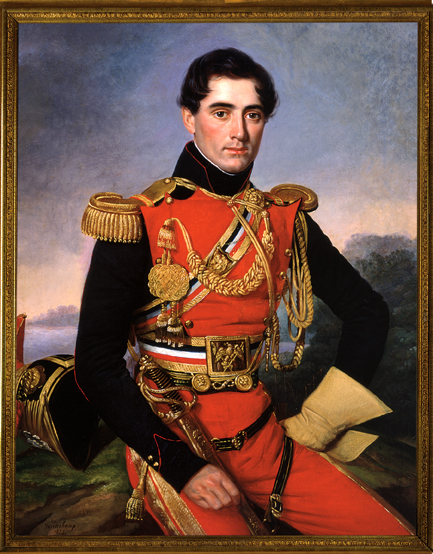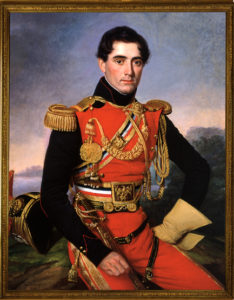Jean Joseph Vaudechamp
In the 1830s, French painter Jean Joseph Vaudechamp regularly visited New Orleans during the winter months to paint portraits of the city's elite French Creoles.

Courtesy of Louisiana State Museum
“Antoine Jacques Philippe de Marigny de Mandeville”. Vaudechamp, Jean-Joseph (Artist)
Although he was in New Orleans for only a relatively brief period, French painter Jean-Joseph Vaudechamp almost single-handedly transformed the direction of portrait painting in Louisiana. During the 1830s, Vaudechamp regularly visited New Orleans during the winter months, where he painted neoclassical portraits, often of elite French Creoles. On the most basic level, his success as a portrait painter in New Orleans encouraged other European artists to try their fortunes in the New World. More profoundly, he provided a model of academic practice to which many others aspired, introduced a full-fledged neoclassical style of painting in Louisiana, and offered clients a sophisticated visual conception of selfhood and identity.
Early Life and Career
Jean-Joseph Vaudechamp was born on December 20, 1790, in Rambervillers, France. His father, Jean-Baptiste Vaudechamp, was the leader of a choir at the local church. His mother, Elisabeth Bontemps, was a native of Rambervillers. The family moved to Paris following the French Revolution to live with his father’s aunt. She had married Abbé Jacques Delille, a noted poet and translator who was—fortunately for an aspiring artist—a friend of painter Anne-Louis Girodet de Roussy-Trison.
Vaudechamp may have studied privately with Girodet before entering the École des Beaux-Arts, an influential French art school, on August 20, 1811. Girodet seems to have favored Vaudechamp as a student—though it is unclear whether for reasons of talent or temperament. In 1817, Vaudechamp debuted at the Salon, an art exhibition in Paris. He exhibited most years through 1848, a period when portraits depicting middle-class citizens were gradually accepted as an appropriate subject for public display. Vaudechamp married twice, first to Anne Engler in 1819. Five years later, he remarried and had three children with Marie-Rosalie Fouquet.
Vaudechamp in Louisiana
Vaudechamp embarked from Le Havre on November 10, 1831, undertaking what would be the first of seven winter residencies in New Orleans. As was common among artists, his studios were invariably near the city center, in what is today the French Quarter. Vaudechamp’s talents were immediately recognized in Louisiana. His refined neoclassical portraits appealed to the plantation owners and merchants in New Orleans and along the banks of the Mississippi River. Wealthy French Creoles, flush with cash from cotton and sugar, were especially eager to commemorate their success with portraits. Perhaps identifying with their countryman, citizens of Gallic ancestry provided the majority of Vaudechamp’s commissions.
According to biographer William Dunlap, Vaudechamp earned the astonishing sum of $30,000 during his first three seasons painting in New Orleans. Vaudechamp’s success encouraged a number of artists to try their fortunes in the New World, including Jacques Amans, Adolphe Rinck, and François Fleischbein. On at least two occasions, Vaudechamp sailed from France on the same vessel as his colleagues.
Vaudechamp’s interpretation of the neoclassical style is marked by polished finishes, highlighted by dashes of impasto (thick layers of paint) to denote details such as jewelry. According to William Keyes Rudolph, Vaudechamp’s portraits place the sitters in a self-contained world that mirrors the isolation they faced in the 1830s. As members of a gradually marginalized subgroup, Creoles sought to maintain their identity within the wider context of Louisiana and American society. Often, Vaudechamp heightened this self-containment by setting his figures against a greenish background. With this device, Vaudechamp focused attention on the face and increased the dramatic effects of light and shadow.
Vaudechamp’s portraits convey neoclassical values of simplicity, rationality, humility, and, above all, the important role of individual character. The artist successfully communicated the sitter’s character or inner life by imbuing the depicted gaze with a liveliness unmatched by other artists working in Louisiana. While his 1833 masterpiece Jean Bernard Xavier de Marigny de Mandeville relies on an elaborate, brilliant red uniform for much of its impact, the face of the young officer ultimately demands attention. Yet, Vaudechamp’s portraits rarely are idealized. Rosa Colon, Madam Théodore Bailly Blanchard, for example, reveals the ravages of time on an older lady’s face. The portrait is far from flattering, but chronicles the sitter’s unselfconscious comfort with her appearance and celebrates experience honestly won.
Vaudechamp’s portraits became progressively more complex during the seven winters in New Orleans. By 1837, he often painted three-quarter-length portraits with two or more sitters. The settings became increasingly elaborate, including furniture, columns, and drapery, as well as landscape details glimpsed through an open window.
Throughout his stays in New Orleans, Vaudechamp returned to France each year to pursue modest commissions. After 1839, he ended his sojourns to Louisiana. In France, he continued to exhibit his work at the Salon in Paris, winning a third-class medal in 1842. According to art historian William Keyes Rudolph, Vaudechamp was considered a competent painter of relatively minor importance in France. Competition for commissions was fierce, and market conditions did not favor portraitists. Vaudechamp’s influence on portrait painting in Louisiana, however, is undeniable. He died in 1866.
Until recently, Vaudechamp’s work has remained obscure outside of Louisiana. A number of Vaudechamp’s paintings are in the collections of The Louisiana State Museum, The Historic New Orleans Collection, The Ogden Museum of Art, The New Orleans Museum of Art, and The Herman Grima-Gallier House. Many paintings remain in private collections as well.
